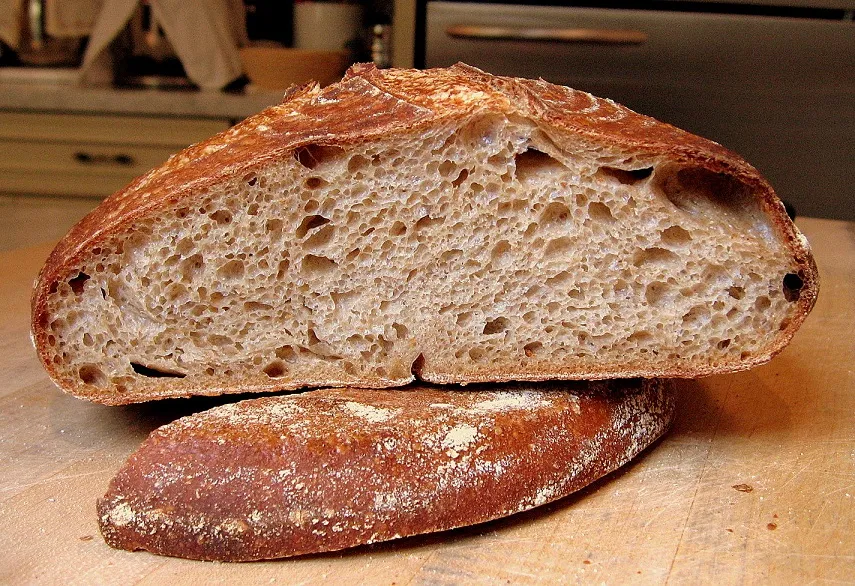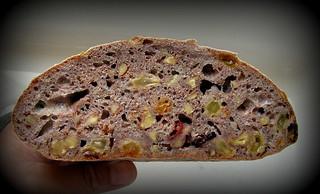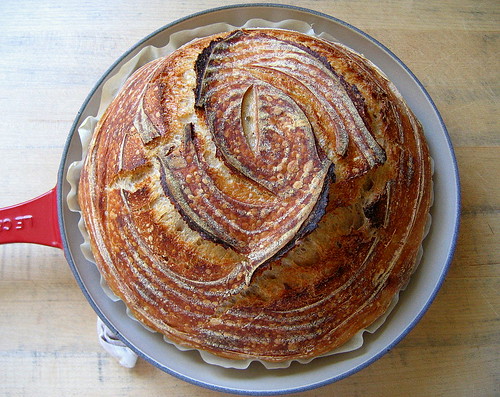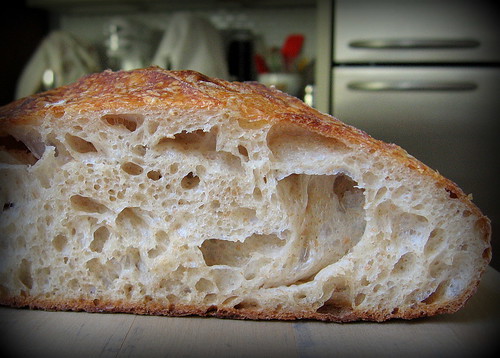
I'm having a good time baking my way through "Bread" by Jeffrey Hamelman. Here are three Hamelman formulas I tried recently.
This beer bread used two starters - a liquid levain and a rye sourdough. According to Hamelman, each starter contributes different flavor characteristics to create a nice, full-flavored bread. I baked the loaf on a baking stone. Instead of a cast iron combo cooker or "magic" SS bowl, I decided to try Sylvia's hot towel method for generating steam. The oven spring was not very impressive and I didn't get "ears", but I'm not sure if that was because I didn't create enough steam or if I didn't develop and/or shape the dough properly.
When eaten plain, I found the bitterness from the beer too strong, but other eaters quite liked the taste. Although, when eaten with some pastrami, I hardly detected any bitterness. The crumb was wonderful. It was moist and slighty chewy. And it had that nice sheen from the gelatinized starch.
Even though it's springtime, I was dying to make the harvest bread which is a walnut loaf with golden raisins and dried cranberries. As you can see my bread turned out very dense and slightly gummy. Slices tasted okay after toasting, so it wasn't a complete loss. I should have extended my fermentation since I did not add the optional instant dry yeast. I was a bit absent minded that day since I was suffering from a terrible migraine. I read somewhere that a baker's feelings are present in the product they bake. I don't know if that's true or not, but my head was definitely feeling dense and gummy that day.
My mom is a huge fan of pain de mie so I made her a pullman loaf. I prefermented 17% of the flour and also added about 10% discarded starter with the hope of extending the shelf life. I've had a 13x4x4-inch pullman pan for years now and I normally use it (without the lid) for baking tea cakes. This is the first time I've used the pan for bread. I've never noticed until now that my pan is not completely square! The pan is 3/8-inch wider at the top than the bottom which gave me a trapezoidal shaped loaf.
And now a non-Hamelman loaf. I'm still practicing my Tartine basic country bread.
:) Mary
- emkay's Blog
- Log in or register to post comments







absolutely fantastic. The beer bread really has a nice color to its crumb and the blisters are great too! Your Tartine doesn't look a smidgen worse than Robertson's, if not even better :)
I was very happy to see the nice color of the beer bread when I took it out of the oven. Very coppery. Thanks for commenting, MisterTT!
Beautiful crust and blistering emkay. :) What beer did you use that made it bitter? Would a different beer perhaps make it less bitter? How did you hold your lame when you slashed the beer bread? If you held it at 90 degrees to the dough, it wouldn't have opened into nice ears. You need a smaller angle to achieve those ears, But I also suspect it might have something to do with the slack nature of the dough. Some loaves tend to spread horizontally more than vertically.
Nice Tartine, too.
Best,
Syd
Hi Syd. Hamelman called for a dark ale In his formula. We're an IPA and sour beer household. So the only non-IPA, non-sour beer I had was Guinness which I keep around for making chocolate cake. I'm sure that contributed to the bitterness. I think I will try using a different beer next time. I cut straight down into the dough instead of at an angle, but I too have a feeling it might be the nature of this dough.
(edited for clarity)
They all look great. Your photography is very nice.
The baking was done over a two week period so it was manageable. Thanks for commenting David. Hope you're having fun with your new grain mill. :)
.
Those are some beautiful looking loaves. I love baking bread with beer and you are probably right to think the Guiness was the culprit for the bitterness.
Regards,
Ian
All of these breads are just wonderful!
Well done and happy baking
All look fabulous, Mary! Great job all around.
in my opinion, ears that you seek are dependent on many factors but two are key in inducing it: The surface on which the bread is baked on, and the presence of continuous source of radiant heat around the loaf.
For instance, the garlic bread shown below were all baked together, but the top row were on stone on a lower rack, while the bottom ones were baked on a metal sheet placed above. Continuous radiant heat from the stone, plus the presence of a radiant heat from the metal sheet above created an upward lift to the bread which is helps form ears. The top loaves did not have a matching stable heat source from below, and the top heat was that of the oven heating elements which sealed the scoring pattern as soon as it was exposed thereby not allowing a formation of ears.
Khalid
I had considered placing another stone on the rack above the bread to create that "hearth" effect that you describe, but as you have shown, it looks like a metal sheet pan will do. Thanks for the advice Khalid!